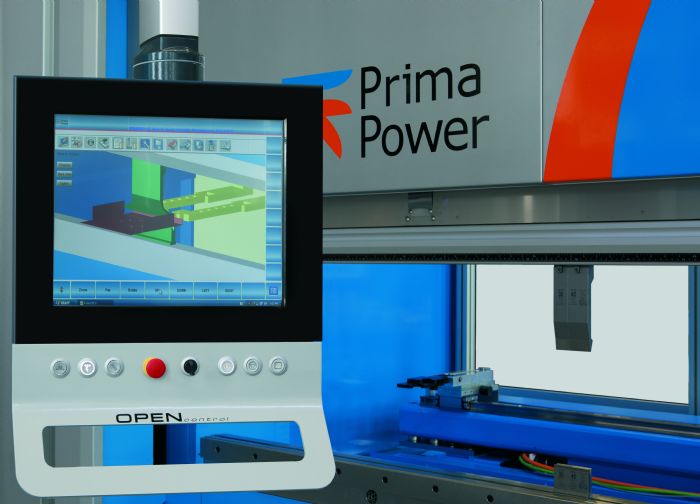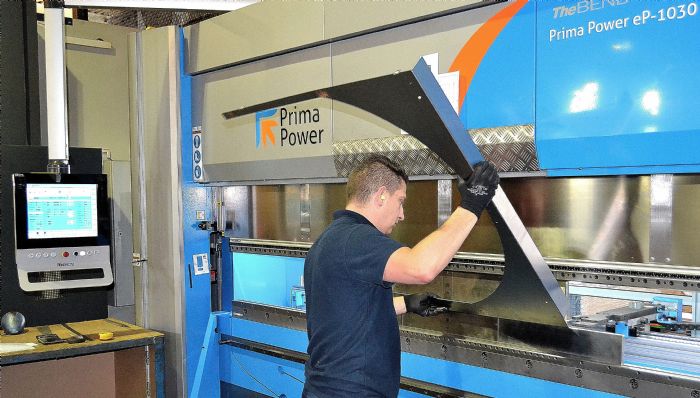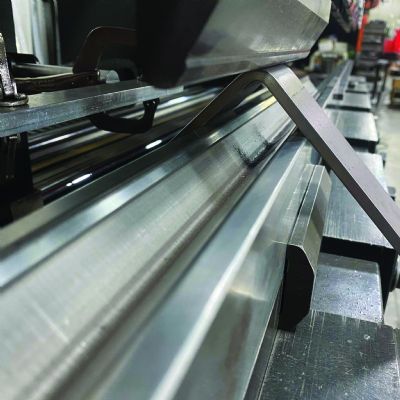Fabricators can expect a modern press brake to provide repeatability and dimensional accuracy to 0.005 mm, due to a few key design characteristics of the brakes. These include, explains Croft, the adoption by OEMs of O-frame machine designs that minimize or eliminate the tendency of the machine frame to twist or yaw under tonnage; and force delivery systems (such as the belt-and-pulley setup that Prima Power employs) that evenly distribute tonnage across the entire bed of the press brake. This design eliminates the need to employ any kind of deflection-compensation or CNC crowning system.
Process Control Starts with Sheet-Thickness Gauging
“So, when it comes to ensuring quality on the shop floor, the performance of a newer press brake is not the deciding factor. When it comes to accuracy and repeatability,” says Croft, “you have to appreciate and control the entire process—critical variables such as consistency of the workpiece material (thickness, mechanical properties and grain direction, for example) and the quality of the tooling.”
Where, then, can fabricators focus their efforts when looking to improve quality and productivity from their press-brake operations? Croft offers two focal points: adjusting for material variability, and paying attention to design for manufacturability.
 “The machines themselves have evolved to become very user-friendly interfaces for the operators, and as long as fabricators invest in good, precision-ground tooling, the brakes will perform as designed,” he says. “When we do see inconsistency in bend accuracy and repeatability, often it’s due to material-thickness variation throughout a stack of blanks. Even a difference of just a few thousandths of an inch in thickness can cause a 2 or 3-deg. variation in bend angle.”
“The machines themselves have evolved to become very user-friendly interfaces for the operators, and as long as fabricators invest in good, precision-ground tooling, the brakes will perform as designed,” he says. “When we do see inconsistency in bend accuracy and repeatability, often it’s due to material-thickness variation throughout a stack of blanks. Even a difference of just a few thousandths of an inch in thickness can cause a 2 or 3-deg. variation in bend angle.”
To adapt for material variability, in nearly every case when bending mild steel or even galvanized material, the simplest, most affordable—and reliable—solution is to affix a thickness-measurement gauge to the press brake. “We then can measure the material thickness as part of the bending process, and adjust the depth of the ram penetration into the die to achieve the desired bend angle,” says Croft. “Often there’s no need to adopt the more expensive optical-gauging systems, based on laser-measuring technology, which require a more time-consuming bend, measure and rebend process. With the thickness gauge, we feel like we’re fixing the problem before it even appears.”
Design for Manufacturability
When it comes to best practices for designing parts for press-brake bending, Croft sees perhaps the biggest challenge metal fabricators face today: the disconnect between product design and manufacturing on the plant floor.
“So many manufacturers have product designers focused on developing more intricate and complex parts, using modern CAD tools,” Croft says. “But out on the production floor, press-brake programmers and operators might see these parts in an entirely different way—and often simply cannot find a way to make the parts on the press brake, no matter how good the brake, and the tooling.”
He has a suggestion for solving this disconnect: Provide the design team with a seat of offline programming (OLP) software that will allow for simulating the bending operations and verifying programmability of the part designs, before they ever reach the plant floor.
“OLP software contains all of the modeling for the press brakes and tooling on the floor,” he explains. “So, if the designers can’t develop a process in the design studio to form the parts, they need to go back to drawing board and redesign the parts until they can simulate a successful bending process.
“We find that in about half of the shops to which we sell press brakes,” Croft continues, “they’ll now invest in an additional seat of OLP software for their designers. This proves very successful in uniting design and production.”
Precision-Ground Tooling
The last piece of the precision pie, says Croft: investing in precision-ground tooling, which becomes easy for most customers to justify once they see a product demonstration.
“With these press brake tools,” he explains, “we’re really talking about controlling two critical dimensions: the height of the tool (or the tip location), and the precise machining of the groove that’s ground into the tang of the tools. When the operator installs the tools in the ram and then activates the hydraulic clamping system, a perfect bend line results, across the entire tool set. That’s all the fabricator needs to see—no more concerns with the tool being offline on one side of the brake versus the other, or having to flip the tool around to get it to align properly. The result: improved bend accuracy and quality, and faster setups.”
A final note regarding press-brake automation, a hot topic these days.
“There’s a lot of buzz over using robots to tend to press brakes,” Croft acknowledges, “but we see only certain, special applications where this really makes sense. Those are, when a fabricator has maybe three or four parts that prove challenging for one operator to handle, based on their size or weight, or maybe they need to be flipped a few times to achieve the final part shape. Here robotic tending can make sense. Otherwise, when you consider that in most cases a robot will actually increase production cycle time, as well as complicate the programming of the press cell, it can be difficult for a fabricator to cost-justify the automation.”
But what about the challenge of hiring and training skilled press-brake operators? To this, Croft says:
“If you can’t find a skilled operator, what makes you think you’ll be able to find a robot programmer?” MF
View Glossary of Metalforming Terms
See also: Prima Power North America, Inc.
Technologies: Bending







 So goes the reasoning of Paul Croft, bending product manager with Prima Power North America, who tells MetalForming that shops looking to purchase the standard 10-ft. 110-ton electric press brake now typically can find room in the budget for a 150-ton 12-ft. brake, or even a 220-ton 13-ft. machine, for just a relatively small increase in purchase price.
So goes the reasoning of Paul Croft, bending product manager with Prima Power North America, who tells MetalForming that shops looking to purchase the standard 10-ft. 110-ton electric press brake now typically can find room in the budget for a 150-ton 12-ft. brake, or even a 220-ton 13-ft. machine, for just a relatively small increase in purchase price.

